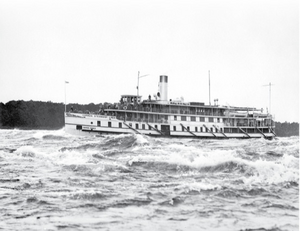Long Sault facts for kids
Long Sault was a powerful section of rapids in the St. Lawrence River. These rapids were located west of Cornwall, a city in Ontario, Canada. For many years, the Long Sault rapids made it very hard for ships to travel along this important river.
Contents
What Were the Long Sault Rapids?
The Long Sault rapids were a natural part of the St. Lawrence River. They were a series of fast-moving, rough waters. Imagine a river flowing quickly over rocks and uneven ground. This creates a challenging path for boats.
Why Were They a Problem for Ships?
For a long time, the Long Sault rapids acted like a big roadblock. Ships found it very difficult, and sometimes impossible, to pass through them safely. This meant that goods and people couldn't easily move up and down the St. Lawrence River. As ships got bigger and more trade happened, this problem became even more serious.
Building the St. Lawrence Seaway
To solve the navigation problem, a huge project was started in the 1950s. This project was called the St. Lawrence Seaway. Its goal was to make the St. Lawrence River easier for large ships to use.
The Moses-Saunders Power Dam
A key part of the St. Lawrence Seaway project was building the Moses-Saunders Power Dam. This massive dam was constructed to control the river's flow. It also helped create hydroelectric power, which is electricity made from moving water. The dam made the area around the rapids much calmer and deeper. This allowed ships to pass through easily.
The Impact of Flooding: The Lost Villages
Building the dam and making the river navigable had a big effect on the land nearby. A large area had to be flooded with water. This was necessary to create the deeper, calmer waters needed for the seaway. Sadly, this flooding meant that several small communities were covered by water. These communities in Ontario are now known as the Lost Villages. People living there had to move to new homes.
Long Sault's Legacy Today
Even though the rapids themselves are gone, the name "Long Sault" lives on. The modern town of Long Sault, Ontario, is named after the historic rapids. Also, the Long Sault Parkway, a scenic road, takes its name from this important part of the river's history.


